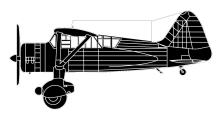
ASN Wikibase Occurrence # 16263
This information is added by users of ASN. Neither ASN nor the Flight Safety Foundation are responsible for the completeness or correctness of this information.
If you feel this information is incomplete or incorrect, you can submit corrected information.
| Date: | Thursday 6 August 1942 |
| Time: | |
| Type: |  Westland Lysander Mk II |
| Owner/operator: | 116 Sqn RAF |
| Registration: | L4795 |
| MSN: | |
| Fatalities: | Fatalities: 1 / Occupants: 2 |
| Aircraft damage: | Destroyed |
| Location: | Near Howden, Yorkshire, England -
 United Kingdom United Kingdom
|
| Phase: | En route |
| Nature: | Military |
| Departure airport: | RAF Leconfield |
It was the horses behavior that first drew Bob's attention to the aircraft, that was flying unusually low and heading, on a collision course, straight for some overhead cables that crossed the field from Boothferry Bridge to Knedlington. The aircraft came through a gap in Winters Wood, from the direction of Howden Dyke its landing wheels just touching the top of the wheat corn. At first Bob Walker thought the aircraft was attempting a landing by flying under the cables, but just when it looked that the aircraft would do it, the aircraft lifted and flew slap bang into them. The plane, a Lysander (L4795) of 116 RAF Squadron was on an calibration anti-defence system flight and had probably taken off from RAF Leconfield near Beverley that morning with a crew of two. The pilot, Flying Officer Ralph Emerson Jenkins, in the front seat, and Sergeant John Hawksworth, the wireless operator/rear gunner in the rear seat.
I suppose I should have been frightened but it did not seem real," recalled Bob Walker. "My two horses, on the other hand were terrified, they were only young. I could not believe what I was seeing, the little plane fell apart as it cart-wheeled, tail over wingtip, across the field, pieces breaking off and scattering all over the place until it came to rest in the dry ditch."
Stopping only to tether the two horses Bob Walker ran across the field to the crashed aircraft.
" Everything was quiet now apart from the airman who was trapped by his harness in what was left of the aircraft. At first I though he was German, and then it dawned on me, what sounded like German was Anglo-Saxon swearing." The surrealism of the situation he now found himself in stayed with Bob Walker for a very long time.
"There was I laid in the bottom of the ditch, surrounded by aircraft wreckage that stank of petrol, trying to cut this young lad free of his harness with a knife which I could have ridden (censored) to London on, because I could not operate the release box, and trying to stop him from further damaging his injured right hand as he tried himself to release it, dangling helplessly upside down, he was barely conscious but still furious. He called me a useless so and so and told me to **** off". I told him, " If this bloody thing sets on fire, I'll **** off all right, but I doubt if thou will".
When for no reason that Bob Walker knew of, and most certainly nothing to do with his efforts with his penknife, Sgt. Hawksworth suddenly fell free of his harness on top of Mr. Walker who was now pinned in the ditch bottom by the profusely bleeding body of the airman (it would seem in retrospect, Bob Walker had indeed operated the harness release mechanism correctly, but the weight of Sgt. Hawksworth's slumped body had prevented the release clasp from springing open).
Struggling to disentangle himself, and now motivated by the strong smell of aircraft fuel and the sight of ammunition Bob began to pull Sgt. Hawksworth clear of the wrecked aircraft, some pieces of which was smouldering alarmingly. By this time some other people had arrived at the site of the crashed plane, some workers from the flax mill, on Knedlington Road, four Land Army girls who had been working in an adjacent field, and a Mr.George Arthur Shirbon who lived in Hailgate Howden, he had been in a field on the south side of Boothferry Road when heard a rustling among the corn. Looking up he saw the aeroplane only a few yards away coming towards him at corn level. He dropped his bicycle and fell on it as the plane passed over him. Between them they carried Sgt. Hawksworth back to the flax mill yard where he was given a measure of first aid by Dr.Wigglesworth (senior) of Howden, prior to being taken to York Military Hospital.
Rescuers found the body of the pilot, F/O Jenkins later. He had been thrown from the aircraft on impact and his body had landed away from the main wreckage, unfortunately he was already dead.
Crew:
Pilot:F/O Ralph Emerson Jenkins RAF killed.
Wop:A/Gnr:Sgt John Hawksworth RAF injured.
Sources:
Air-Britain: Royal Air Force Aircraft L1000-N9999
http://webcache.googleusercontent.com/search?q=cache:CbFytNJnf78J:uk.geocities.com/deko476/Lysander.htm+Lysander+L4795&hl=en&ct=clnk&cd=1&gl=uk
Revision history:
| Date/time | Contributor | Updates |
|---|---|---|
| 23-Mar-2008 00:27 | JINX | Added |
| 08-Jul-2013 14:33 | JINX | Updated [Location, Source, Narrative] |
| 28-Oct-2018 17:05 | Nepa | Updated [Operator, Location, Departure airport, Operator] |
Corrections or additions? ... Edit this accident description
The Aviation Safety Network is an exclusive service provided by:


 ©2024 Flight Safety Foundation
©2024 Flight Safety Foundation